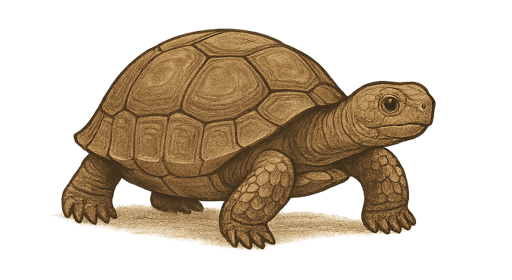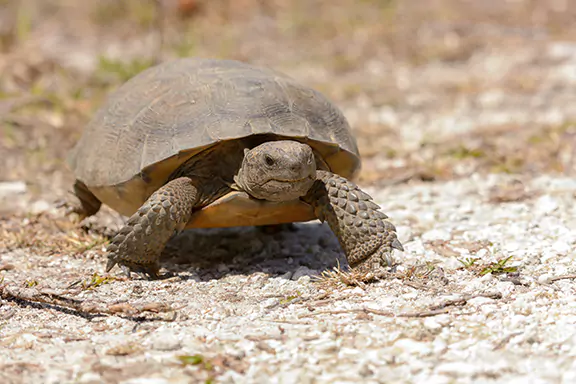Gopher tortoises are one of the most recognizable yet misunderstood wildlife species found across the southeastern United States. With their distinctive burrows and quiet presence, they play a crucial role in maintaining healthy ecosystems, especially in Florida’s longleaf pine forests and other dry upland habitats.
If you’ve come across a tortoise on your land or spotted a mysterious hole in sandy soil, it’s important to know what you’re looking at. Gopher tortoises (Gopherus polyphemus) are a threatened species in Florida, and their burrows are protected under state law. Whether you’re a property owner, land manager, or simply a curious observer, understanding how to identify a gopher tortoise can help you stay compliant with wildlife regulations and contribute to the conservation of this keystone species.
Let’s explore what makes these creatures so unique—and how to recognize them in the wild.
What a Gopher Tortoise (Gopherus polyphemus) Looks Like
Gopher tortoises are easy to identify once you know what to look for. These land-dwelling reptiles are well adapted for digging and survival in hot, sandy environments. Here are the key characteristics that set them apart:
Size and Shape
Adult gopher tortoises typically measure 9 to 15 inches long and weigh between 8 and 15 pounds. Their bodies are low to the ground and built for burrowing, with a slightly flattened, domed carapace (top shell) and sturdy limbs.
Shell and Color
Their shell ranges from grayish-brown to dark brown, often with a rough, weathered texture. The underside (plastron) is usually light yellow to tan. The shell is oval-shaped and lacks the bright, patterned markings common in aquatic turtles.
Legs and Feet
One of the easiest ways to identify a gopher tortoise is by its elephantine hind feet and flattened, shovel-like front legs, which are adapted for digging. The forelimbs are covered in thick scales to help them push through soil as they excavate burrows.
Head and Eyes
Gopher tortoises have a scaled, rounded head with dark eyes and a short snout. They often appear dusty from digging and may retreat quickly into their shells if approached.
These physical features not only make them excellent diggers but also help them survive extreme summer heat and avoid predators by retreating underground.
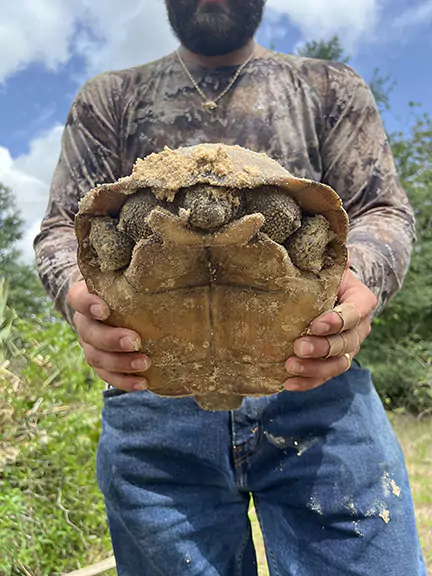
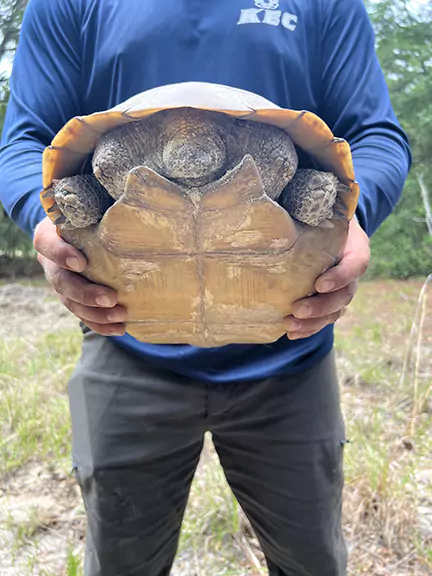
Male vs. Female Gopher Tortoises
While male and female gopher tortoises look similar at a glance, there are a few subtle physical differences that can help you tell them apart, especially if you get a clear view of the underside or tail.
Plastron Shape
One of the most reliable ways to differentiate a male from a female gopher tortoise is by examining the plastron, or the flat part of the shell underneath.
Males typically have a concave (curved inward) plastron, which helps them mount females during mating.
Females have a flat or slightly convex plastron.
Tail Length
Tail size is another helpful clue.
Males have longer and more pointed tails, with the vent (cloaca) located farther from the base of the shell.
Females have shorter, more rounded tails, with the vent closer to the shell’s edge.
Size Differences
In general, female tortoises are slightly larger than males of the same age group, especially in areas where larger body size supports better reproductive success. However, this can be hard to assess without measuring or comparing multiple individuals.
While these differences can be useful in field studies or relocation work, most casual observers don’t need to identify gender unless required for a wildlife survey. Still, learning to recognize these traits can give you a deeper understanding of the species and its reproductive behaviors.
Where Gopher Tortoises Live
Gopher tortoises are found throughout the southeastern United States, with the largest populations occurring in Florida. Their habitat preferences are closely tied to the types of environments that support burrowing, basking, and a diverse herbivorous diet.
Gopher Tortoise Habitat
Gopher tortoises thrive in dry, sandy uplands with well-drained soils. These include:
Longleaf pine forests
Oak scrub
Sandhills
Coastal dunes
Dry prairies
Pine flatwoods with an open canopy
These habitats are typically sunny, sparsely vegetated, and dominated by native grasses and low-growing plants. The open landscape allows tortoises to move freely, dig burrows, and feed on a wide variety of native vegetation.
Historically, the gopher tortoise was most abundant in the longleaf pine ecosystem—a once-vast forest type that stretched across the Southeast from Florida to eastern Texas. Due to logging, agriculture, and development, much of this ecosystem has been lost, contributing to habitat decline for the species.
Geographic Range
Gopher tortoises occur in:
Florida (entire state)
Southern Georgia
Alabama
Mississippi
Louisiana
Small portions of South Carolina
This distribution is known as the “eastern population” of the species. West of the Mississippi River, populations are more scattered and face greater conservation challenges.
Soil and Sunlight
Sandy soils are essential for tortoises to dig stable burrows and to regulate temperature underground. These soils also support the plant species they rely on for food. Gopher tortoises often select sites with abundant sunlight, which helps maintain the warmth needed for digestion, egg development, and general survival.
Understanding where gopher tortoises live is critical for landowners and developers who may be planning construction in regions where this species occurs. Recognizing suitable habitat is often the first step in identifying the presence of gopher tortoises on a property.
How to Recognize a Gopher Tortoise Burrow
Even if you don’t see a gopher tortoise itself, spotting its burrow is often the first sign that one is nearby. Gopher tortoises spend most of their lives underground, so identifying a burrow accurately is essential, especially for anyone involved in land management or development.
Burrow Shape and Size
A gopher tortoise burrow has a distinct appearance:
The entrance is oval-shaped, with a flat bottom and a domed top.
The size of the opening usually matches the width of the tortoise’s shell.
Most entrances measure between 8 and 12 inches across, though larger adults can create even wider burrows.
Each burrow can extend up to 40 feet long and reach depths of up to 10 feet underground. Inside, the temperature and humidity remain stable year-round, offering critical protection from predators, extreme weather, and the heat of summer.
The Sand Apron
One of the most recognizable features is the mound of loose sand—often called an apron—just outside the entrance. This soil is pushed out as the tortoise digs and may show signs of recent activity, such as tracks, drag marks, or fresh claw scrapes.
Aprons are usually free of vegetation and located in open, sunny areas with sparse groundcover. You may also find them along trails, firebreaks, or in disturbed areas where sandy soil is exposed.
Active vs. Inactive Burrows
An active burrow may show:
Fresh tracks or claw marks
A clean, well-shaped entrance
Recent signs of use like shed scutes or scat nearby
In contrast, an inactive or abandoned burrow may be partially collapsed, filled with debris, or overgrown with vegetation. However, it’s important to note that even seemingly inactive burrows can still be legally protected in Florida, and a permitted wildlife agent should always make the final determination.
Properly identifying gopher tortoise burrows is essential not only for compliance with wildlife regulations but also for recognizing the presence of this important species and the ecological value it brings to the landscape.
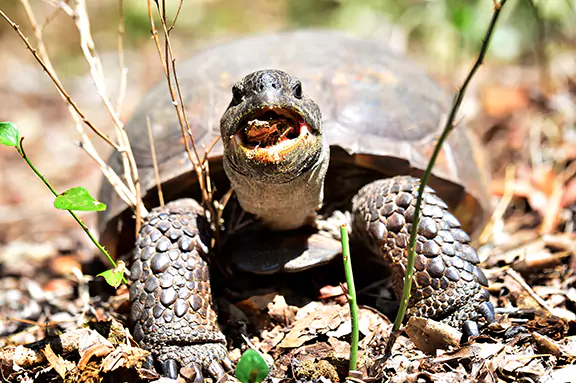
What Gopher Tortoises Eat
Gopher tortoises are herbivores with a broad, adaptable diet made up of native plants. Their feeding habits not only support their own health but also contribute to the health of the ecosystems where they live.
Diet Overview
In the wild, gopher tortoises feed on more than 300 species of plants. They prefer:
Grasses
Broadleaf weeds
Fruits
Flowers
Succulent plants like prickly pear cactus
Their strong jaws and beak-like mouths allow them to tear and chew fibrous plants. While feeding, they help with seed dispersal, which supports the regeneration of plant communities.
Seasonal Shifts
Their diet changes with the seasons and availability of vegetation:
In spring and early summer, they feed heavily on green shoots and flowers.
During the heat of summer, they consume more moisture-rich plants to stay hydrated.
In fall, they often eat fruits and hardy vegetation in preparation for periods of reduced activity.
Feeding Behavior
Gopher tortoises are typically most active during the morning and late afternoon, especially in the warmer months. You may see them foraging near the edges of their burrows, slowly grazing across open ground. They tend to remain within a relatively small home range and will revisit favorite feeding areas regularly.
Understanding their diet can also help landowners manage vegetation in ways that support gopher tortoise habitat, especially in areas with ongoing conservation or relocation efforts.
Other Species Found in Gopher Tortoise Burrows
One of the most remarkable aspects of gopher tortoises is not just their ability to survive, but also the numerous other animals that depend on their presence. Gopher tortoise burrows serve as vital shelter for a wide range of wildlife, making the tortoise a keystone species in the ecosystems where it occurs.
The Gopher Tortoise as a Keystone Species
A keystone species is one whose presence has a disproportionately large impact on its environment. In the case of the gopher tortoise, its burrows provide year-round refuge for over 350 documented animal species. These burrows offer a stable microclimate that protects against predators, extreme temperatures, fire, and flooding.
Common Burrow Co-Inhabitants
Animals known to share or temporarily occupy gopher tortoise burrows include:
Eastern indigo snakes (a federally threatened species)
Gopher frogs
Florida mice
Burrowing owls
Raccoons
Skinks, toads, and lizards
Invertebrates such as beetles, crickets, and spiders
Some of these species are also considered rare, threatened, or endangered, which adds to the ecological value of preserving gopher tortoise habitat.
Ecosystem Benefits
By digging burrows and maintaining open habitat, gopher tortoises indirectly support:
Biodiversity across the longleaf pine ecosystem
Predator-prey balance
Shelter availability in fire-maintained environments
Because so many other animals rely on their burrows to survive, the presence of gopher tortoises is often an indicator of a healthy, functioning ecosystem.
Recognizing the broader role gopher tortoises play helps landowners and environmental professionals understand why the species receives such strong legal protections.
Why Proper Identification Matters
Being able to identify a gopher tortoise, or its burrow, correctly is about more than curiosity. It’s a critical part of staying compliant with environmental regulations and helping protect a species that is facing increasing pressure from habitat loss and development.
Legal Protections
In Florida, the gopher tortoise is listed as a threatened species by the Florida Fish and Wildlife Conservation Commission (FWC). This means it is illegal to:
Harass, capture, or harm a gopher tortoise
Disturb or destroy a gopher tortoise burrow
Relocate a tortoise without a permit from FWC
Violating these rules can result in fines and legal penalties. Other southeastern states also provide state or federal protections, particularly west of the Mississippi River, where populations are even more vulnerable.
Conservation Importance
Proper identification helps:
Prevent accidental harm to tortoises or their burrows during land clearing or construction
Support conservation goals for species linked to the longleaf pine ecosystem
Promote responsible land management and stewardship
Whether you are a homeowner, contractor, or environmental consultant, knowing how to recognize gopher tortoises in the field is a valuable skill that supports both legal compliance and ecological awareness.
Final Tips for Spotting a Gopher Tortoise
If you’re walking a property or managing land in the Southeast, here are a few practical tips to help you identify a gopher tortoise or burrow in the field.
Look for the Right Conditions
Open, sunny areas with dry, sandy soil
Sparse groundcover and native grasses
Edges of trails, firebreaks, or clearings
Check for Burrow Characteristics
Oval-shaped entrance, roughly the size of a dinner plate
Flat bottom and domed top
Sand “apron” pushed out from digging activity
Fresh tracks, claw marks, or tortoise scat nearby
Observe from a Distance
If you see a tortoise:
Watch quietly from a distance to avoid disturbing it
Do not attempt to feed, touch, or move the animal
Note the location and contact a permitted wildlife agent if relocation or site work is planned
Remember, gopher tortoises spend most of their lives underground, so the absence of a visible tortoise doesn’t mean the burrow is unoccupied.
When in doubt, consult with a licensed gopher tortoise agent or biologist. Identifying the species correctly is the first step toward ensuring that your activities remain both legal and environmentally responsible.
Identifying Gopher Tortoises Helps Protect More Than Just One Species
Gopher tortoises are more than just quiet inhabitants of Florida’s sandy uplands—they are essential contributors to the health of entire ecosystems. Learning how to identify a gopher tortoise, recognize its burrow, and understand its role in the environment empowers landowners, developers, and nature enthusiasts to make informed, responsible decisions.
From their distinctive elephant-like feet to the oval-shaped entrances of their deep burrows, these tortoises leave clear signs of their presence. Taking time to observe and properly identify these signs not only helps avoid legal issues, but also supports the protection of a species that countless other animals depend on.
If you think you’ve found a gopher tortoise or its burrow on your property and aren’t sure what to do next, contact a qualified wildlife agent.
